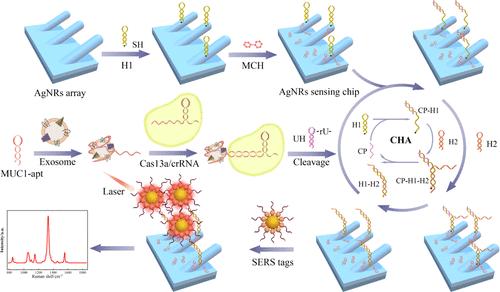当前位置:
X-MOL 学术
›
Anal. Chem.
›
论文详情
Our official English website, www.x-mol.net, welcomes your
feedback! (Note: you will need to create a separate account there.)
CRISPR/Cas13a Trans-Cleavage and Catalytic Hairpin Assembly Cascaded Signal Amplification Powered SERS Aptasensor for Ultrasensitive Detection of Gastric Cancer-Derived Exosomes
Analytical Chemistry ( IF 6.7 ) Pub Date : 2024-11-17 , DOI: 10.1021/acs.analchem.4c03063 Xinyue Gu, Jingjing Zhang, Jing Liang, Xinyu Liu, Xiyu He, Xiaoyuhao Jin, Chenlong Yan, Lianhui Wang, Chunyuan Song
Analytical Chemistry ( IF 6.7 ) Pub Date : 2024-11-17 , DOI: 10.1021/acs.analchem.4c03063 Xinyue Gu, Jingjing Zhang, Jing Liang, Xinyu Liu, Xiyu He, Xiaoyuhao Jin, Chenlong Yan, Lianhui Wang, Chunyuan Song

|
Cancer-derived exosomes carry a large number of specific molecular profiles from cancer cells and have emerged as ideal biomarkers for early cancer diagnosis. Accurate detection of ultralow-abundance exosomes in complex biological samples remains a great challenge. Herein, a novel SERS aptasensor powered by cascaded signal amplification of CRISPR/Cas13a trans-cleavage and catalytic hairpin assembly (CHA) was proposed for ultrasensitive detection of gastric cancer-derived exosomes, which included hairpin-structured recognition aptamers (MUC1-apt), cascaded signal amplification (i.e., CRISPR/Cas13a trans-cleavage and CHA), SERS tags, and silver nanorods (AgNRs) sensing chip. In the presence of SGC-7901 cell-derived exosomes, MUC1-apt specifically bound to MUC1 proteins highly expressed on exosomes via its contained MUC1 aptamer with its exposed RNA fragments activating the CRISPR/Cas13a trans-cleavage to cleave the uracil-modified hairpin reporter, and the cleavage products further triggered the downstream CHA reaction to form numerous duplexes, which can, in turn, capture a large number of SERS tags onto the AgNRs sensing chip to generate a significantly enhanced Raman signal. The proposed SERS aptasensor exhibits good performance on analysis of exosomes, i.e., rapid response within 60 min, single-particle sensitive detection from a 2 μL biological sample, good specificity in distinguishing SGC-7901 cell-derived exosomes against other exosomes, good uniformity, excellent repeatability, and satisfactory recoveries in human serum, and good universality to expand the detection of multiplex exosomes, which indicates that the SERS aptasensor provides a valuable reference for clinical diagnosis of early cancer.
中文翻译:

CRISPR/Cas13a 反式切割和催化发夹组装级联信号放大驱动的 SERS Aptasensor 用于胃癌来源的外泌体的超灵敏检测
癌症来源的外泌体携带大量来自癌细胞的特异性分子谱,并已成为早期癌症诊断的理想生物标志物。准确检测复杂生物样品中的超低丰度外泌体仍然是一项巨大的挑战。在此,提出了一种由 CRISPR/Cas13a 反式切割和催化发夹组装 (CHA) 级联信号放大驱动的新型 SERS 适配体传感器,用于超灵敏检测胃癌来源的外泌体,其中包括发夹结构识别适体 (MUC1-apt)、级联信号放大(即 CRISPR/Cas13a 反式-切割和 CHA)、SERS 标签和银纳米棒 (AgNRs) 传感芯片。在 SGC-7901 细胞来源的外泌体存在下,MUC1-apt 通过其包含的 MUC1 适体与外泌体上高度表达的 MUC1 蛋白特异性结合,其暴露的 RNA 片段激活 CRISPR/Cas13a 反式切割以切割尿嘧啶修饰的发夹报告基因,切割产物进一步触发下游 CHA 反应形成许多双链体,这反过来又可以, 将大量 SERS 标签捕获到 AgNRs 传感芯片上,以产生显著增强的拉曼信号。所提出的 SERS 适配体传感器在外泌体分析方面表现出良好的性能,即 60 分钟内的快速响应,对 2 μL 生物样品的单颗粒敏感检测,在区分 SGC-7901 细胞来源的外泌体与其他外泌体方面具有良好的特异性,良好的均一性,优异的重复性,在人血清中具有令人满意的回收率,以及良好的通用性,以扩大多重外泌体的检测, 这表明 SERS 适配体传感器为早期癌症的临床诊断提供了有价值的参考。
更新日期:2024-11-18
中文翻译:

CRISPR/Cas13a 反式切割和催化发夹组装级联信号放大驱动的 SERS Aptasensor 用于胃癌来源的外泌体的超灵敏检测
癌症来源的外泌体携带大量来自癌细胞的特异性分子谱,并已成为早期癌症诊断的理想生物标志物。准确检测复杂生物样品中的超低丰度外泌体仍然是一项巨大的挑战。在此,提出了一种由 CRISPR/Cas13a 反式切割和催化发夹组装 (CHA) 级联信号放大驱动的新型 SERS 适配体传感器,用于超灵敏检测胃癌来源的外泌体,其中包括发夹结构识别适体 (MUC1-apt)、级联信号放大(即 CRISPR/Cas13a 反式-切割和 CHA)、SERS 标签和银纳米棒 (AgNRs) 传感芯片。在 SGC-7901 细胞来源的外泌体存在下,MUC1-apt 通过其包含的 MUC1 适体与外泌体上高度表达的 MUC1 蛋白特异性结合,其暴露的 RNA 片段激活 CRISPR/Cas13a 反式切割以切割尿嘧啶修饰的发夹报告基因,切割产物进一步触发下游 CHA 反应形成许多双链体,这反过来又可以, 将大量 SERS 标签捕获到 AgNRs 传感芯片上,以产生显著增强的拉曼信号。所提出的 SERS 适配体传感器在外泌体分析方面表现出良好的性能,即 60 分钟内的快速响应,对 2 μL 生物样品的单颗粒敏感检测,在区分 SGC-7901 细胞来源的外泌体与其他外泌体方面具有良好的特异性,良好的均一性,优异的重复性,在人血清中具有令人满意的回收率,以及良好的通用性,以扩大多重外泌体的检测, 这表明 SERS 适配体传感器为早期癌症的临床诊断提供了有价值的参考。


















































 京公网安备 11010802027423号
京公网安备 11010802027423号